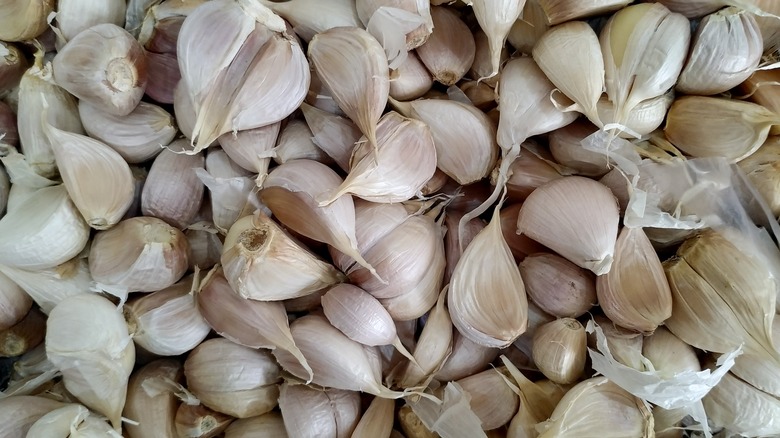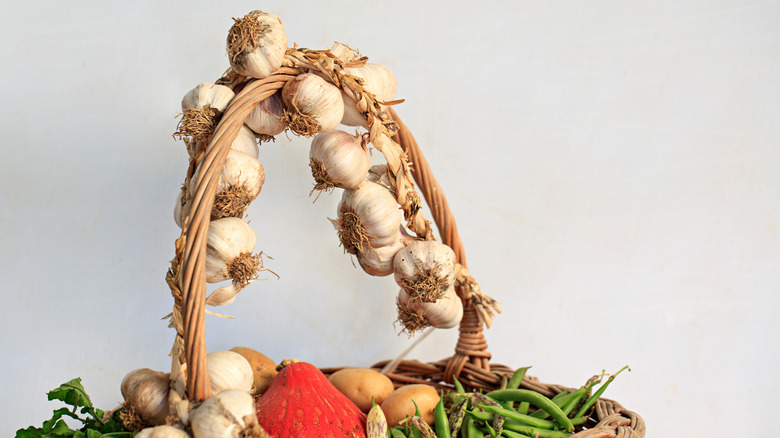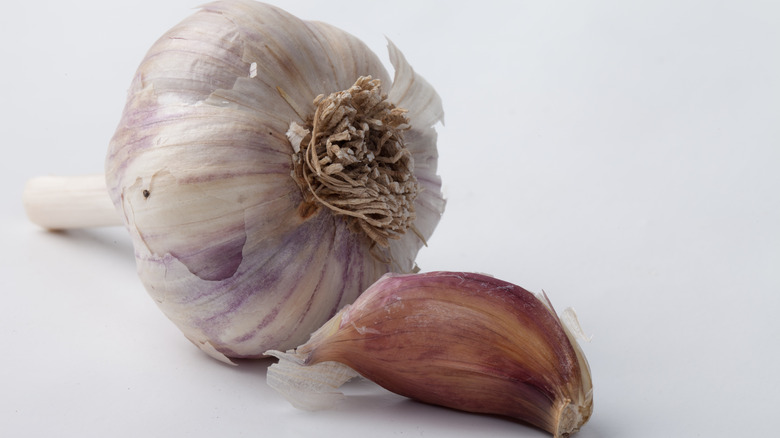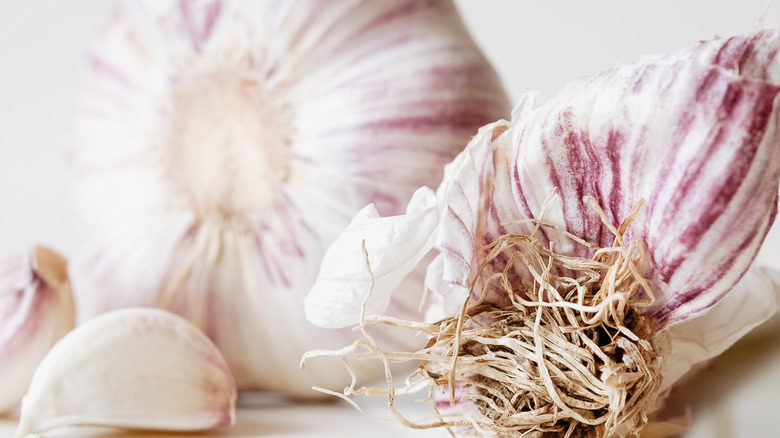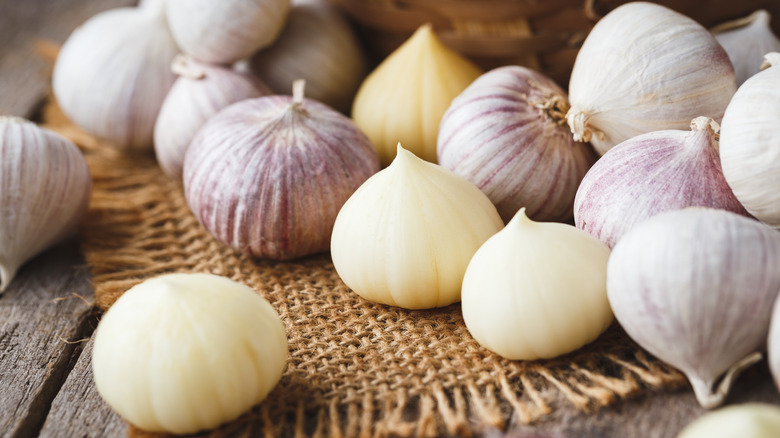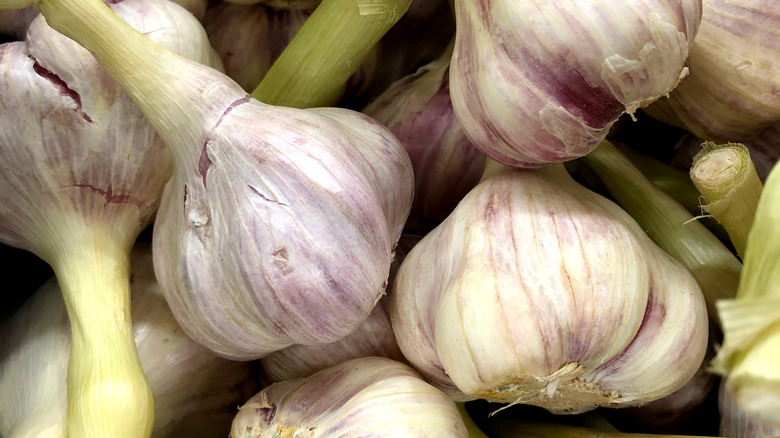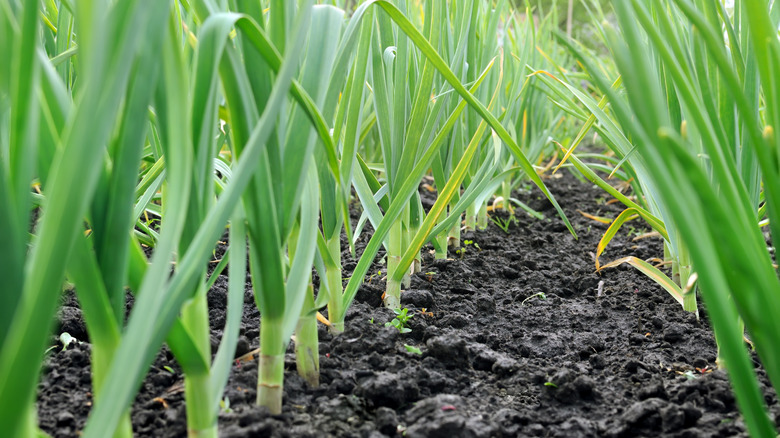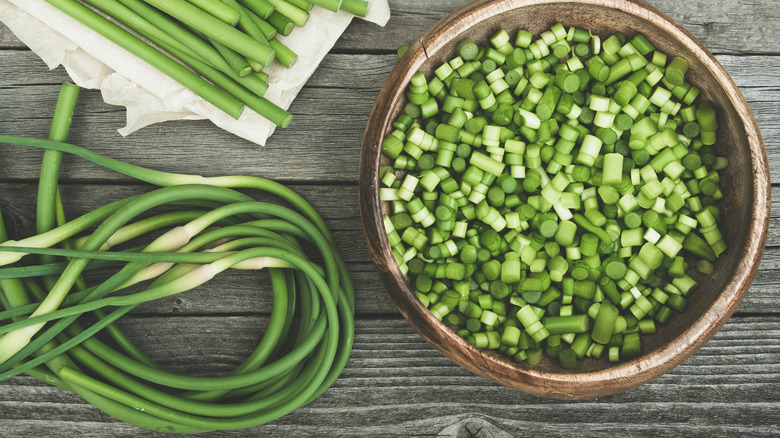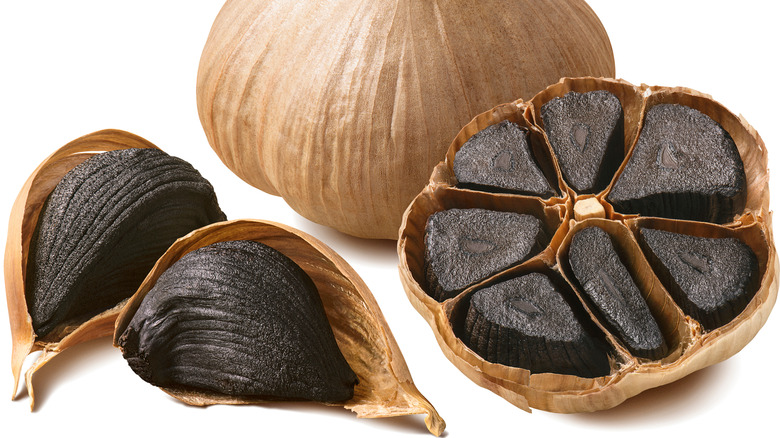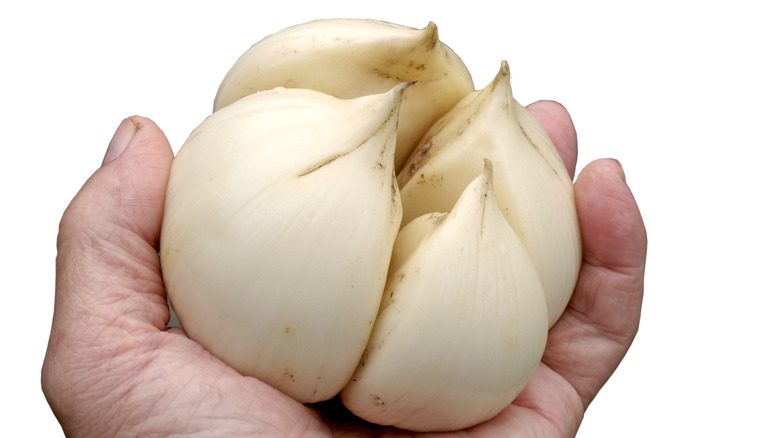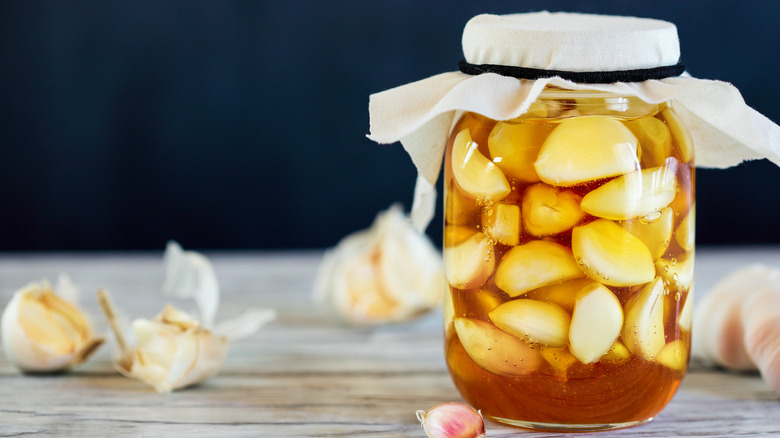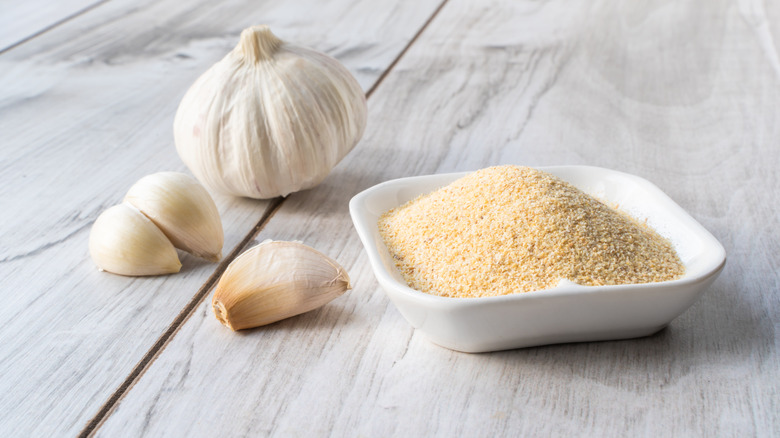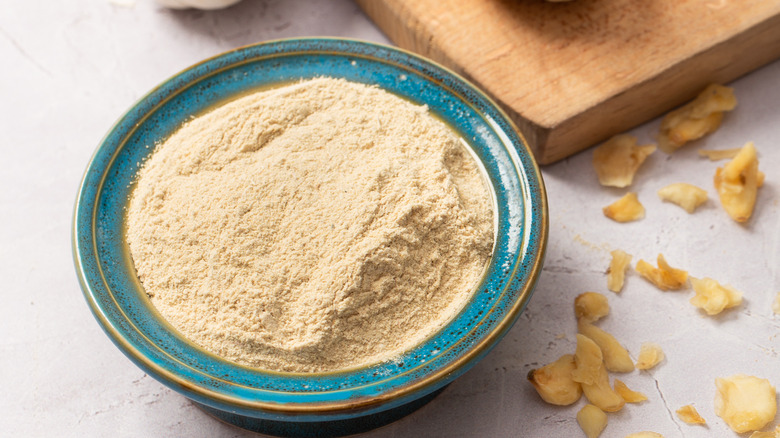12 Variations Of Garlic And When To Use Them
The world loves garlic. This dynamic allium, which has been cultivated for more than 5,000 years, is used in almost every cuisine on Earth, according to the University of Wyoming. Beyond its numerous culinary applications, garlic is prized for its healing properties and some cultures even believed it had supernatural abilities to ward off vampires (via CNN).
These days, people are more likely to hang up garlic in their kitchens than on their windowsills. And those who use garlic to treat their high blood pressure and cholesterol probably take advantage of it in the form of pills (via WebMD). The ways we use garlic in cooking have expanded, too. Not only can you find various cultivars in the grocery store, but the methods of garlic preparation have expanded as well.
Next time you visit the grocery store or your local farmer's market, you'll want to avoid any confusion about which variation of garlic to buy and when to use it. Keeping reading to find out more about the different types of garlic and various products that highlight those pungent cloves.
Artichoke
Artichoke garlic is likely the image that pops into your head when you hear the word "garlic." That's because it's the most common variety sold in U.S. grocery stores, per the University of Vermont. It can grow almost anywhere and should be harvested early in the season. This tasty bulb is of the softneck variety of garlic, one of the two major types of garlic. Since softneck garlic doesn't usually grow a flowering stalk, it's easy to tie together, which has earned it the moniker, "braiding garlic."
Artichoke garlic gets its name from the way its cloves overlap each other, giving the cluster the appearance of an artichoke (via Harvesting History). Some note that its distinct flavor is reminiscent Dijon mustard. That interesting taste makes artichoke garlic versatile and perfect for everyday use.
Artichoke garlic would be a perfect choice for our aïoli mashed potatoes with chives recipe. That subtle mustardy flavor will pair wonderfully with the rich aïoli. If it's a main dish you're after, consider using artichoke garlic in this garlic butter shrimp recipe. Artichoke garlic's lively flavor will hold its own against the shrimp without overpowering it. And of course, artichoke garlic would be out of this world in a classic cheesy garlic bread. Basically, if any recipe calls for garlic, this would fit the bill.
Rocambole
Rocambole is a popular variety of hardneck garlic. Hardneck garlic is more closely related to wild garlic than softnecks since it produces a flowering stalk that grows ramps, and the bulbs produce fewer, but bigger cloves.
If you'd like to grow garlic at home, the rocambole family is a good choice. Just know that this variety doesn't keep for a long time, so use it up quickly. We don't think that should be too hard, though, considering rocambole's irresistibly complex flavor. While it is generally described as sweet, some cultivars are spicier than others. Its intense flavor makes rocambole suitable for eating raw (via The Garlic Clubb).
Because this variety is so delicious in its natural state, we suggest dipping your toes into the rocambole pond with our chimichurri recipe. This zippy Argentinian sauce combines cilantro, parsley, olive oil, lime juice, honey, cumin, salt, pepper, and four whole cups of minced garlic. It's super simple to make, as all you have to do is blend the ingredients up in a food processor. This bright sauce's garlicky kick goes well with anything from steak to pizza.
Standard purple stripe
Standard purple stripe is another hardneck family member that you need to try. It's ideal for roasting since the cloves become so sweet you might think someone added sugar to them. Gourmet Garlic Gardens even suggests trying this garlic in ice cream.
Don't be put off by the standard purple stripe's small cloves — what they lack in size, they make up for in intensity of flavor. Plus, they have a longer shelf life than rocambole and are still quite easy to peel. The standard purple stripe comes in two major sub-varieties: the glazed and marbled groups. (The former is recognizable by its purple cloves.)
Regardless of color, purple stripe would be a perfect fit for our chipotle and roasted garlic compound butter. Or, if you're more adventurous, you could try that garlic ice cream we mentioned above. Gourmet Garlic Gardens suggests letting some vanilla ice cream soften and then adding roasted standard purple stripes. Refreeze the combo before eating your frozen garlic treat.
Solo garlic
Also called pearl garlic, solo garlic contains a single large clove instead of multiple small ones. According to The Guardian, it originated in China's Yunnan province and the bulb's unique shape is partially due to the region's warm climate. Back in 2013, German grocery chain Lidl began selling solo garlic and gave it the nickname "Lazy Garlic" because of how simple it is to peel it. You can use this bulb for any situation that calls for softneck or hardneck varieties. According to Professional Secrets, solo garlic isn't as pungent as its peers, but it will do the trick in a stir fry or give some slices a dip in the fryer to make garlic chips.
If you want to avoid the frustration of removing that pesky skin but you can't find solo garlic, not to worry. There are a few easy ways to peel garlic, but crushing happens to be our method of choice. First, place your garlic clove flat on your cutting board and lay your knife sideways atop it. Then, press down with the heel of your hand and push. The peel will come right off.
Fresh garlic
Fresh garlic is harvested and sold before it's dried (via Specialty Produce). Sometimes called wet garlic, this variation of garlic has been used for centuries, but has recently become more popular, especially in European farmer's markets (via Chocolate & Zucchini). If you're interested in trying it, be on the lookout for the bulbs in spring and early summer.
Fresh garlic is a zero-waste food, since the whole product can be used. The stem is too tough to eat raw, but works well in any recipe where you'd use leeks. Depending on how thick the membranes of the cloves are — the part that later turns into the papery skin — you may need to remove them. If you do, Chocolate & Zucchini suggests blending the membranes with olive oil to make a garlic cream spread. As for the cloves, just slice them up and you're good to go. Fresh garlic is great in any dish for which you want a milder garlic flavor. Like rocambole, fresh garlic is especially delicious raw.
According to Healthline, raw garlic may just be healthier than cooked, since it contains more allicin, the compound behind the bulb's health benefits. Be careful, though, raw garlic can come with negative side effects including heartburn and acid reflux, so the outlet recommends eating only one to two cloves a day.
Spring garlic
Even though both fresh garlic and spring garlic are referred to as wet garlic, they are different. Spring garlic is an even more immature form of garlic. Unlike fresh garlic, it consists of bulbs that haven't yet been divided into cloves (via Garden Betty). Also known as green garlic or baby garlic, spring garlic is only available a few months out of the year and tends to arrive by February or March.
If you can't find it at your local farmer's market, spring garlic is rather easy to grow in your own garden. In fact, you can try planting organic garlic cloves straight from your kitchen. Make sure you harvest it early so that you don't find yourself with more fully-formed bulbs (though there are worse problems to have than accidentally growing fresh garlic).
Spring garlic is an unexpected replacement for chives or scallions, so why not try it in our classic French omelet or prepare this multi-purpose green garlic purée. The green leaves are an excellent addition to salads, pesto, or in compound butter.
Garlic scapes
A garlic scape is the flowering stalk of a hardneck garlic plant. Scapes appear in spring and should be harvested early if you plan to eat them. If you let garlic scapes mature, they'll turn into flowers and, eventually, garlic bulbs for planting. Most scapes are straight, but rocambole varieties actually curl into a little double loop. Some people even use scapes in floral bouquets (via Cedar Circle Farms).
Scapes don't keep for long, lasting only a couple of weeks in the fridge, or a few days on the counter in water. But since there are so many ways to eat them, we don't think they'll remain a while in your kitchen anyway. Scapes are delicious enough to simply sauté and eat by themselves or as a vegetable side dish. You can even pickle this variation of garlic. Use them in place of spring onions in any recipe, such as our flaky scallion pancakes.
Black garlic
The striking color of black garlic isn't the clove's natural shade. Rather, it's garlic that has undergone the Maillard reaction. According to The Science of Cooking, amino acids, heat, and time work together in this chemical reaction that changes the flavor of food and causes it to brown. Some experts, including authors of a study published in the Journal of Food and Drug Analysis (via Science Direct), maintain that black garlic is fermented because of the changes to its "physiochemical properties." Whether that is actually the case is a hot-button issue in the food community, with chefs such as Dave Arnold of the French Culinary Institute insisting, "[Black garlic] isn't fermented. It's a break down product" (via StarChefs).
What we do know for sure is that black garlic is tasty. The Maillard process results in a smoky, milder garlic that's just a little bit tangy. As an added bonus, black garlic's health benefits are myriad. It's full of antioxidants, might be an immune booster, and could even fight cancer (via WebMD). While black garlic is becoming more widely available in grocery stores and online, if you're patient, you can always make it at home in your rice cooker.
Black garlic works well in everything from pizza and pasta dishes to spreads and sauces. You can even indulge your sweet tooth — blend some black garlic into our ultimate fudgy brownies for a funky twist on a classic dessert.
Elephant garlic
While elephant garlic isn't technically a variation of garlic (it's in the leek family), it's often used as a garlic stand-in for cooking since it's a similar aromatic. However, there are some major differences between softneck garlic and elephant garlic. For one, elephant garlic usually only has about six cloves — way fewer than what you'll find in a softneck bulb. Elephant garlic is also yellower than true garlic (via Gardening Knowhow).
Elephant garlic tastes quite a bit different from regular garlic, as well. It offers more of an oniony flavor, which isn't surprising, considering it's in the leek family. You shouldn't shun elephant garlic for its deceptive name, though; it's delicious in its own right.
Instead of thinking of elephant garlic as a lesser form of garlic, try reframing it as a vegetable. It's amazing deep-fried into chips or slivered raw on salads. And, per Specialty Produce, elephant garlic is filled with vitamins A,C, and E.
Pickled garlic
When people hear the word "pickle," they often think of cucumbers, but there are plenty of other candidates suitable for brining. That includes pickling garlic, which is a fun way to eat the bulb. Buy it pre-packaged or go DIY — you only need vinegar, spices, jars, and a bit of patience. A vinegar bath will reduce raw garlic's familiar punch of flavor, resulting in subtler, but no less enjoyable, taste. Plus, your breath won't suffer as much thanks to that soak.
Now that you've procured your pickled garlic, what should you do with it? Serve the cloves on an antipasto platter, or add them to an antipasto salad recipe. Or, if you're like us, eat it right out of the jar. But, if you're looking for something tasty and beautiful, you could try laba garlic. According to Panda Cheffy (via Medium), this pickled allium is made during the Chinese Laba Festival in December. It's made with only garlic, vinegar, and sugar, and the cloves turn a vibrant, jade green color. Laba garlic is traditionally served alongside dumplings.
Granulated garlic
If you're anything like us, your pantry is stocked with spices. Perhaps you bought some of them for one recipe, and now you aren't sure how else you can use them. If granulated garlic is one of those spices, let us help you out. First thing's first, what is granulated garlic exactly? Simply put, it's dehydrated chopped garlic.
Granulated garlic's coarse grains make it a good substitute for fresh garlic in liquid recipes, such as sauces and dressings, as well as in spice blends. All in all, it's a better choice than garlic powder if you want to mimic fresh garlic because it mixes better with both wet and dry ingredients (via MySpicer). You can even reconstitute granulated garlic as a way to save time and money.
Bear in mind that swapping out dried and fresh ingredients can be a little tricky. MySpicer suggests you use ½ teaspoon of granulated garlic for each garlic clove. If you're using granulated garlic instead of powder, use double what the recipe suggests.
Garlic powder
While they are both forms of dehydrated chopped garlic, the difference between granulated garlic and garlic powder comes down to texture: Garlic powder is ground much more finely, almost like dust. It also has a much stronger flavor than the granulated variety, which makes it a great choice for quick-cooking recipes or marinades (via MySpicer).
According to Still Tasty, if kept in a cool and dark cupboard, garlic powder can have a shelf life of three to four years. Technically, garlic powder never goes bad; it just loses flavor as it ages. The outlet suggests that you taste and smell the powder after rubbing a bit in your hand; if it doesn't taste like garlic, it needs to be replaced.
As with granulated garlic, you'll need to do some math when substituting powder for another variation of garlic. You only need ¼ teaspoon of garlic powder for every fresh clove. If you're using powder instead of granulated, halve the suggested amount.
